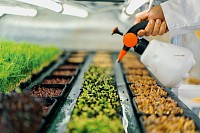Innovations in Seed Genetics for Higher Crop Yields

The image depicts a scientist studying plant samples, symbolizing advancements in seed genetics for higher crop yields.
Innovations in seed genetics have played a pivotal role in transforming agriculture and improving crop yields. With a growing global population and increasing food demand, there is a pressing need for crops that can produce higher yields while also being resilient to environmental stresses. In this article, we will explore some of the recent innovations in seed genetics that are driving higher crop yields and revolutionizing modern agriculture.
Advancements in Genetic Engineering
Genetic engineering has been a game-changer in seed genetics, allowing scientists to introduce desirable traits into crops with precision. One of the most significant innovations in this field is the development of genetically modified (GM) crops. GM crops are engineered to express traits such as insect resistance, herbicide tolerance, and improved nutritional content. These traits can lead to higher yields by reducing crop losses due to pests and weeds, as well as improving the overall health and vigor of the plants.
For example, Bt cotton, which is genetically engineered to produce a protein toxic to certain insects, has been widely adopted by farmers around the world. Studies have shown that Bt cotton can significantly reduce the need for insecticide sprays, leading to higher yields and increased profits for farmers.
Another example is Golden Rice, which has been engineered to produce beta-carotene, a precursor to vitamin A. Vitamin A deficiency is a major health problem in many developing countries, leading to blindness and other serious health issues. Golden Rice has the potential to address this issue by providing a more nutritious staple food.
Advancements in Molecular Breeding Techniques
Molecular breeding techniques have also contributed to higher crop yields by allowing breeders to select for desirable traits more efficiently. One such technique is marker-assisted selection (MAS), which involves identifying markers linked to genes of interest and using them to select for those genes in breeding programs. MAS has been used to develop crops with improved yield potential, disease resistance, and drought tolerance.
Another promising technique is genome editing, which allows scientists to make precise changes to the DNA of plants. One of the most widely used genome editing techniques is CRISPR-Cas9, which has revolutionized the field of plant breeding. CRISPR-Cas9 allows scientists to edit the DNA of plants with unprecedented precision, enabling the development of crops with targeted improvements in traits such as yield, quality, and resistance to biotic and abiotic stresses.
Advancements in Trait Stacking
Trait stacking involves incorporating multiple desirable traits into a single crop variety. This can lead to synergistic effects, where the combined traits result in higher yields than would be possible with each trait individually. For example, a crop variety that is resistant to multiple pests and diseases, as well as tolerant to drought and heat stress, would have a higher likelihood of producing a successful harvest under challenging conditions.
Trait stacking can be achieved through traditional breeding methods, but it is more commonly done using genetic engineering techniques. By stacking multiple traits into a single crop variety, breeders can develop crops that are more resilient and productive, helping to ensure food security in a changing climate.
Case Studies
One of the most compelling case studies of innovation in seed genetics for higher crop yields is the development of hybrid rice varieties. Hybrid rice varieties are created by crossing two genetically distinct rice lines to produce offspring with superior traits, such as higher yield potential and improved disease resistance. Hybrid rice varieties have been shown to produce significantly higher yields than traditional rice varieties, leading to increased food security and income for farmers.
Another example is the development of drought-tolerant maize varieties. Maize is a staple crop for millions of people around the world, but it is highly susceptible to drought. By using molecular breeding techniques, scientists have developed maize varieties that are more resilient to drought stress, leading to higher yields in areas prone to water scarcity.
Challenges and Future Directions
While innovations in seed genetics have led to significant improvements in crop yields, there are still challenges that need to be addressed. One of the major challenges is the regulation of GM crops, which varies widely from country to country. Some countries have strict regulations that limit the adoption of GM crops, while others have more lenient regulations.
Another challenge is the potential for unintended consequences of genetic engineering, such as the development of resistance in pest populations or the transfer of transgenes to wild relatives. Continued research and monitoring will be essential to mitigate these risks and ensure the safe and sustainable use of genetically modified crops.
Looking to the future, there is great potential for further innovations in seed genetics to drive even higher crop yields. Advances in technologies such as CRISPR-Cas9 and other genome editing techniques hold promise for developing crops with traits that were previously difficult or impossible to achieve. By continuing to invest in research and development in seed genetics, we can help ensure a more sustainable and food-secure future for generations to come.
Conclusion
In conclusion, innovations in seed genetics are revolutionizing modern agriculture and driving higher crop yields. Advances in genetic engineering, molecular breeding techniques, and trait stacking have enabled the development of crops that are more resilient, productive, and nutritious than ever before. While there are challenges and risks associated with these innovations, the potential benefits are immense. By continuing to invest in research and development in seed genetics, we can help ensure a more sustainable and food-secure future for all.
